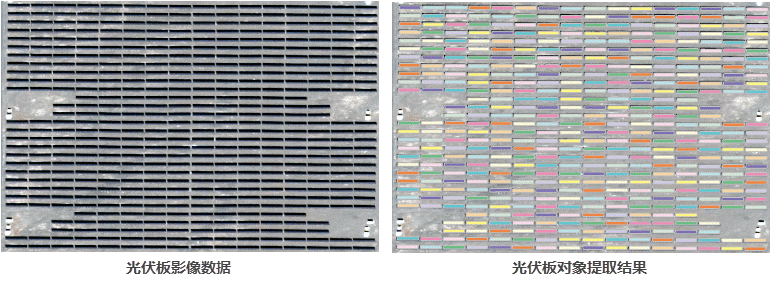Object Extraction
Object extraction utilizes neural network models to preselect regions of interest within imagery, then classifies pixels within these regions to obtain object boundary information, thereby supporting object-level spatial analysis.
Main Parameters
The following figure demonstrates object extraction results of photovoltaic panels in a specified area. Using the instance segmentation model, independent photovoltaic panels are differentiated and extracted to facilitate subsequent statistical analysis.

- Function Entry: Toolbox-> Machine Learning-> Imagery Analysis-> Object Extraction tool.
- File Type: Supports dataset or folder selection. Enables batch processing to improve inference efficiency. Default: Dataset.
- Datasource/Dataset: Required when File Type selects Dataset. Choose the image or mosaic dataset containing target objects.
- File Path: Required when File Type selects Folder. Specify the folder path containing *.tif, *.img format images for automatic reading.
- Model File: Select object extraction model file (*.sdm).
- Probability Threshold: Filters detected objects by confidence score. Only retains objects with scores exceeding this threshold. Default: 0.5.
- Deduplicate Threshold: Typically 0.3-0.7. Default: 0.3. Resolves overlapping candidate boxes via Non-Maximum Suppression (NMS), removing boxes with intersection over union (IoU) ratios exceeding this threshold.
- Single Step Operation Amount: Number of images processed per inference batch. Default: 1. Higher values increase memory usage but reduce processing time.
- Processor Type: Choose between CPU or GPU processing. GPU delivers faster computation.
- GPU Number: Specifies GPU device ID for processing. Default: 0. Supports multi-GPU inference.
- Other Parameter Settings: Enables additional parameters:
- Bounds Dataset/Datasource: Performs custom bounds inference using vector dataset extents.
- Return: When checked, generates minimum bounding box dataset for results (suffix: "bbox").
- Result Data: Sets output datasource and dataset name.
- Run: Click to execute extraction. Progress information displays in Python window.
Related Content
 Machine Learning Environment Configuration
Machine Learning Environment Configuration



